Jane Austen: Stourhead, Bath, Chawton mark bicentenary of her death
Fans — better known as Janeites — are gearing up to celebrate a Jane Austen milestone.
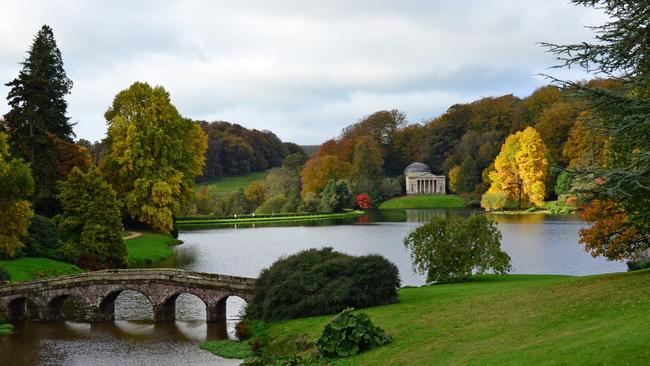
“Jane Austen didn’t come here,” says Hugh, one of the volunteer staff at Stourhead’s 18th-century landscaped gardens in Wiltshire, southwest England, “but she should have done.” The great English novelist, known to enjoy a good view, would have admired these celebrated lakeside gardens and their Romantic-era features — Palladian bridge and grotto, ruined cottage and tumbling waterfall — not least for seeing them in their Georgian heyday.
Our vantage point over the gardens, restored to their former glory by Britain’s National Trust, is the Temple of Apollo, which any Austen fan worth the name will instantly recognise as the spot where Keira Knightley’s Elizabeth Bennet rebuffed a rain-drenched Mr Darcy’s first declaration of love in Joe Wright’s acclaimed 2005 movie adaptation of Pride and Prejudice.
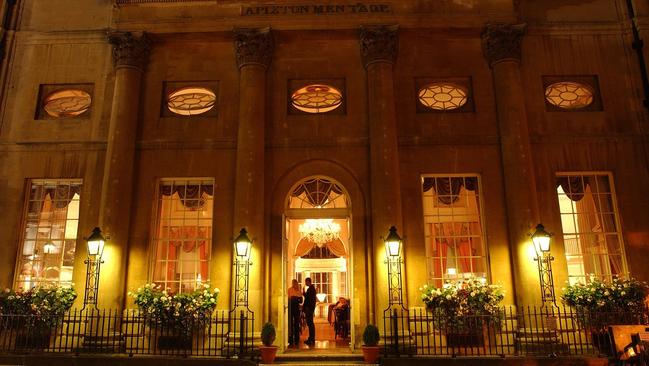
Hugh’s neat line is one he looks set to repeat time and again this year, the bicentenary of the author’s death, when her international legion of fans, or Janeites, will descend on many of the places associated with perhaps the best loved of novelists. As well as Stourhead and other locations featured in movie and TV adaptations of Austen’s novels, especially period-piece Lacock village in Wiltshire, the various places associated with the author’s actual life and with her characters are there to be ticked off. Add to the mix this year’s crop of exhibitions and events, talks, pageants, specially commissioned Austen-themed art trails and statues, and any self-respecting Janeite is likely to be looking at a full-blown road trip through the author’s southern England heartlands.
I leave Stourhead on the short journey to Bath, the Georgian city and World Heritage site where the Austen family lived at the beginning of the 19th century and which is the setting for much of her fiction.
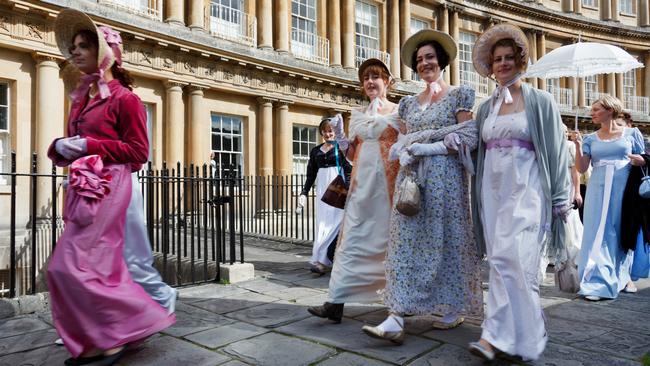
The city’s annual Jane Austen Festival, the place to see hard-core devotees decked out in muslin and lace, holds the official Guinness World Record for the most people dressed in Regency costumes — 409 — which looks sure to be surpassed on September 9, when the festival holds a charity promenade past grand set pieces like the Royal Crescent.
It helps, of course, that historic and beautiful Bath so persuasively recalls Austen’s own period — its stone-built terraces and crescents regularly feature as film locations, complete with the obligatory geese flocks and hackney chaises — and that many of the attractions and activities described in her fiction and letters remain central to experiencing the city. Choose from tea at the fabled Assembly Rooms or “take the waters’’ (the mineral-rich thermal water was a popular curative in Georgian times) straight from the central fountain at the iconic Pump Room. Visitors can soak at the modern thermal spa, with its spectacular rooftop pool, or walk Austen’s favourite haunts, not least the grand old Sydney Gardens, scheduled for restoration, which the author knew well from the family’s stay at 4 Sydney Place.
All this and the key backdrops Austen gave her characters, including the gravel walk where Captain Wentworth and Anne Elliot whisper bonding intimacies in Persuasion, are described in the tourism office’s free downloadable audio guide. For an introductory exhibition and a newly commissioned waxwork of the novelist, try the Jane Austen Centre on Queen Square.
The Austens spent six years in Bath, but 4 Sydney Place and their other rented homes are either closed to visitors or in some cases have been demolished.
Bath might have provided Austen with a rich source of literary material but it made her neither happy nor productive. She spent the rest of her short life in Hampshire, which deservedly claims her as its own. Austen was born and died in the county, at Steventon and Winchester respectively, and did much of her writing in the family home, now Jane Austen’s House Museum, in the pretty village of Chawton. In this resonant old house I wander through period interiors furnished with relics that have been known to reduce Janeites to tears, not least her very own writing table and the coverlet she made with her mother and sister.
Here too is her topaz ring, which the British authorities recently categorised as a national treasure, banning its export after US pop star and self-confessed Janeite Kelly Clarkson paid more than $300,000 for it at auction.
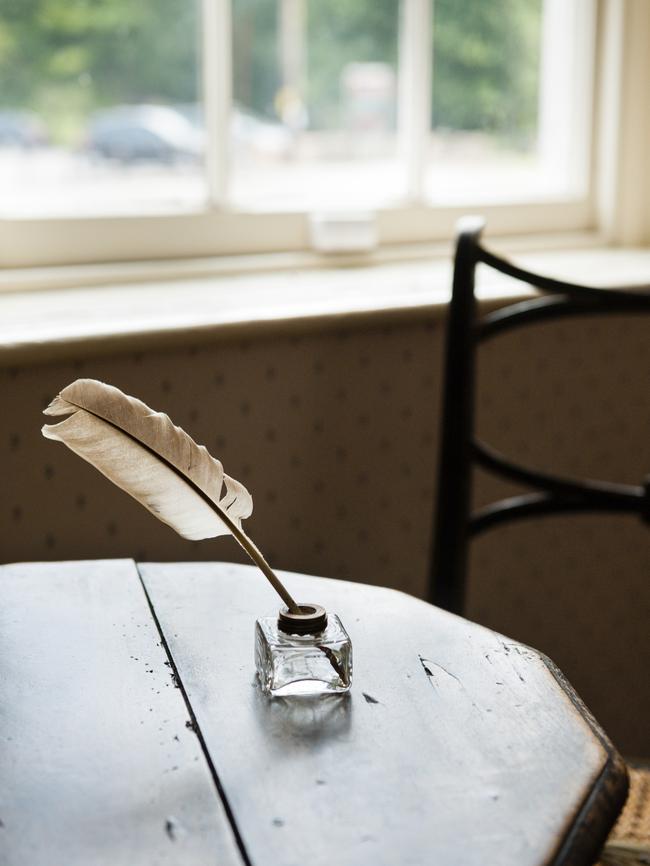
The museum, committed to recreating the interiors as they were in Austen’s day, has discovered surviving fragments of Georgian wallpaper that it has commissioned Hamilton Weston Wallpapers to recreate, using traditional hand block printing processes. These wallpapers now hang in the rooms where the fragments were found; you’ll also find rolls of them (at an eye-watering $400 a pop) in the museum shop along with replica topaz rings, which many fans wear as badges of belonging.
Austen liked to divide her Chawton days into three, with the mornings devoted to writing, evenings to recreation or reading, and afternoons to walking. I follow the short walk she often made through the village to the Great House, home to her brother Edward, where the restored 400-year-old wood-panelled interiors are rich in Austen echoes, not least the reading alcove she especially favoured.
The house continues the literary theme by maintaining a unique library of writings by early woman writers, including ones Austen especially admired such as Frances Burney, and staging a rolling program of displays. I also make time for the fine old tea rooms and explore the extensive gardens’ lawns and “wildernesses”. In the walled kitchen garden, which Austen’s brother built, a herb bed inspired by 18th-century writer Elizabeth Blackwell’s A Curious Herbal has recently been created.
I leave Chawton on the signed 1.6km Jane Austen Trail into Alton where the Allen Gallery on Church Street is staging an exhibition on the life and work of the writer’s Alton-based apothecary, William Curtis. Austen had a close association with the market town, more so than rival claimants, as the lady at the Allen Gallery is keen to remind me. “Jane didn’t even like Bath,’’ she says. “And she only went to Winchester to die.”
“Not entirely true,’’ says Winchester resident and Blue Badge Guide Christina Reid who shows me around England’s ancient capital. “As a child Jane visited Winchester regularly with her father, a clergyman, in the course of his duties. Also, it was her express wish that she be buried in the cathedral here.”
Austen lies beneath the cathedral’s magnificent gothic nave, the longest of any in Europe, covered by a simple stone slab that makes no reference to her novels. Her passing in 1817 went unnoticed by the wider world, and when the poet John Keats visited Winchester two years later, calling it “the pleasantest town I ever was in”, he made no mention of her. Austen’s growing renown was to change all that; a brass plaque erected beside her grave a few decades later describes her as “known to many by her writings” and a stained-glass window was subsequently commissioned in her honour. Beneath the window I admire a flower display funded by the Jane Austen Society of North America. It’s a measure of her enormous appeal that this cathedral, which once housed the bones of England’s earliest kings and drew massed pilgrims to the remains of the revered St Swithun, is now chiefly known as the country’s foremost literary shrine.
Winchester has gone especially big on Austen, and in often unexpected ways. I am surprised to see the author quoted, “You must be the best judge of your own happiness” (Emma), in antique fonts on the walls of the town’s multi-storey carpark. There are more Jane quotes, among them the intriguing, “I see more distinctly thro’ rain”, at the town’s The Mysterious Miss Austen exhibition, along with impressive displays of author portraits, personal possessions and manuscripts, one containing an alternative ending for Persuasion.
I conclude my pilgrimage outside the house on College Street, Winchester, where Austen’s life ended on July 18, 1817. A brass plaque commemorates her passing, though an elderly lady sitting on the bench in the gardens opposite, her nose deep in a copy of Pride and Prejudice, pays her the lasting tribute.
Jeremy Seal was a guest of Visit Britain.
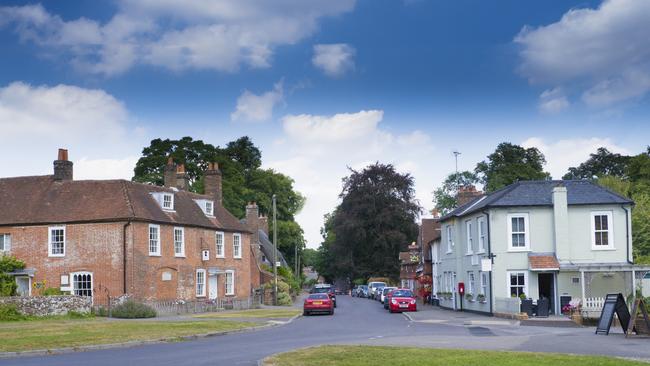
AND ALSO CELEBRATE
This is the 125th anniversary of the first appearance of Arthur Conan Doyle’s Sherlock Holmes. Take in the Sherlock Holmes Museum at 221B Baker St, London; sherlockholmes.co.uk. Check out the memorabilia and try Holmes’s favourite dish, Cumberland sausage, at Sherlock Holmes Pub in Westminster; sherlockholmes-stjames-co.uk. London Walks offers Holmes-themed tours; walks.com. It is also the 20th anniversary of the publication of the first Harry Potter novel by J.K. Rowling, Harry Potter and the Philosopher’s Stone. Explore Harry’s world with a tour of Warner Brothers Studio and visit Platform 9 and three quarters at Kings Cross Station where you’ll find a luggage trolley disappearing through the wall;
CHECKLIST
Many events and exhibitions have been planned to mark the Austen anniversary, especially in Hampshire, including The Mysterious Miss Austen (Winchester, until July 24), Jane and Her Alton Apothecary (Alton until August 20) and The Navy at the Time of Jane Austen; Fighting, Flirting and Fortune (Gosport, July 15 to September 20);
In Bath, the Jane Austen Festival will be held from September 8-17;
Other exhibitions include: Which Jane Austen? (Oxford, June 29 to October29);
Jane Austen in 41 Objects (Chawton and online, throughout 2017);
jane-austens-house-museum.org.uk;
Jane Austen by the Sea (Brighton, until January 8);
Fickle Fortunes: Jane Austen and Germaine de Stael at 200 Years (Chawton, until September 24);


